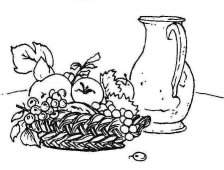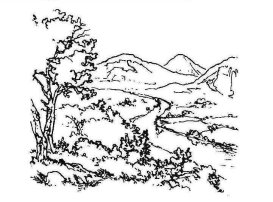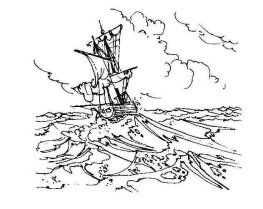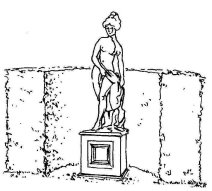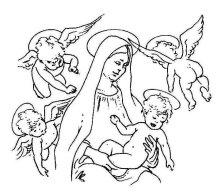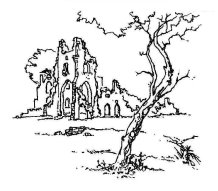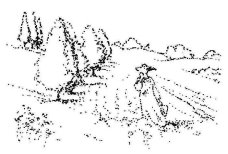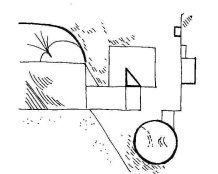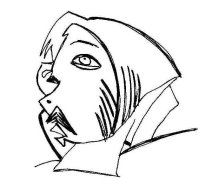Дидактичний матеріал з теми "Мистецтво"
Посібник містить дидактичний матеріал з теми «Мистецтво» для учнів старших класів, а саме: тексти для читання та аудіювання, лексичні та граматичні вправи , завдання для роботи в групах та парах тощо, які сприятимуть розширенню запасу лексики в учнів та розвитку навичок усного мовлення з теми «Мистецтво».
Даний матеріал є корисним доповненням до підручника англійської мови для загальноосвітніх навчальних закладів.
Contest
|
|
|
|
|
|
Reading “The British School of painting”… ……………………… |
4 |
|
|
Listening “The painter”……………………………………………. |
11 |
|
|
Reading “Famous Artists”…………………………………………. |
14 |
|
|
Vocabulary .. ……………………………………………………… |
21 |
|
|
Reading “The Da Vinci Code” …………………………………... |
30 |
|
|
Presentation “Genres of art”…………….......................................... |
34 |
|
|
Grammar ………………………………………………………... .. |
40
|
THE BRITISH SCHOOL OF PAINTING
- The "Golden Age" of English Painting
The period from W. Hogarth to Constable and W. Turner is the period between the 1730s and 1830s. It is rightly considered to be the "Golden Age" of English painting. It was at that time that England took path of capitalist development. It was marked by the general advance in its economic might and national culture and art. Some of the greatest foreign masters were attracted to England. Holbein, Antonio More, Rubens, Van Dyck were almost English painters during a longer or shorter period of their lives. They influenced greatly the formation of the British national painting school.
One of them - the Flemish painter Sir Anthony Van Dyck (1599-1641), a pupil of great Rubens, is considered the father of the English portrait school. He trained a few English pupils, nevertheless his principal imitators and successors were like himself foreigners settled in London.
William Hogarth (1697-1764) was the first great English painter who raised English pictorial art to a high level of importance. He was a man of remarkably individual character and thought. He was the first English painter who brought painting closer to literature and theatre. In his masterpieces The Rake's Progress and The Marriage-a-la-Mode Hogarth showed himself as an innovator. He was the first to invent a story and illustrate it. Being a social painter, he produced his own pictorial drama, showing different scenes of society's social life. His art was a reflection and a commentary on the social condition of his time. Hogarth was a great master of composition, which is perfectly displayed in his series of engravings. The Marriage-a-la-Mode, the moral series consisting of six engravings, displayed one of the sharpest problems of his time - marriage based on money and vanity. Although his narrative pictures were comic and full of satire, his portraiture was honest and original (the most brilliant of them are the portrait of The Shrimp Girl and his Self-Portrait). The portraits of W. Hogarth are penetrating studies of character. The portrait of his face gives an idea of that keen and brave look with which W. Hogarth regarded the world. While looking at the famous The Shrimp Girl, which stands among the masterpieces of the world, we can't help admiring its harmony of form and content, its freshness and vitality. Breaking all the unwritten laws of art of that time, W. Hogarth, a remarkable painter and engraver, showed the terrible evils of the society of those times with unprecedented courage.
Content focus
1. What painting schools influenced the formation of the British national school of painting?
2. Who is considered to be the father of the English portrait school?
3. Whose pupil was Sir Van Dyck?
4. What contribution did W. Hogarth make to the development of English painting school?
Discussion points
1. Describe the economic development of England during the period between 1730s and 1830s.
2. Explain why the 18th century is called the "Golden Age" of English painting.
3. Enumerate peculiar features of British national school of painting.
- The Brilliant School of English Portrait Painting
In the second half of the 18th century narrative and satirical themes lost their leading role in English art. The ruling classes during the years of industrial revolution tried to show in art a glorification of their social position. The most popular form of painting became ceremonial portraits of representatives of the ruling class.
Sir Joshua Reynolds (1723-1792) was the most outstanding portraitist of that period. He was the first President of the Royal Academy of Arts in Britain. He created a whole gallery of portraits of the most famous contemporaries of his time. He gave the decisive impetus to the national temperament. Reynolds painted portraits, group pictures and historical themes. Among his sitters there were the socially prominent people of the time. Reynolds made careful studies of Old Master paintings: Rembrandt, Titian, Raphael. In his writings he evolved a doctrine of imitation, a fact with which he had sometimes been reproached, but wrongly so, since he succeeded in making his borrowings his own and giving to a composite creation a homogeneous, personal and national character. For Reynolds each sitter was not just a physical fact to be recorded, but rather a story to be told. Reynolds succeeded in revealing his sitters' inner world. One of the most perfect paintings in which a great artist had enshrined his dream of woman was The Portrait of Nelly O'Brien. Lighting and colour show the artist's technique at it's best. Reynolds often painted the characters in heroic style and they are not free of idealization (Mrs. Siddons as the Tragic Muse, Cupid Unties the Zone of Venus, etc.)
Thomas Gainsborough (1727-1788) succeeded brilliantly as a portrait painter. A good amateur violinist and a lover of the drama, he was an artistic person. His manner of painting differs from Reynolds'. His portraits are painted in clear tones, where blue and grey colours predominate (The Blue Boy, Mrs. Sheridan). If Reynolds was the solid prose of that age of prose, the incipient poetry was with Gainsborough, whose name is so often coupled and contrasted with his one. Even in the portraits Gainsborough is an out-of-door painter. The backgrounds of his portraits are often the well-observed country scene. T. Gainsborough is the creator of the great English school of landscape painting. His great love for the English country and his delicate understanding of nature are especially felt in the pictures The Watering Place, The Harvest Waggon. Not for nothing was the master a musician. His painting has a quality belonging to this most abstract and fleeting of arts.
Content focus
1. What trend prevailed in painting in the second half of the 18th century?
2. What was Reynolds sometimes reproached with?
3. Why is Gainsborough, though portraitist, considered an out-of-door painter?
Discussion points
1. You are a guide at the hall of British portrait painting of the 18th century. Speak about brilliant representatives of English portrait school.
2. Explain to your listeners why the ceremonial portrait was the most popular genre at that time.
3. Compare the creative work of two brilliant portrait masters: Reynolds and Gainsborough. Pay attention to the difference in their manners of painting.
3. A Glory of English Art — the Landscape Painting
If portrait painting is one of the glories of English art, landscape is the other one; in both directions it rose to supreme height.
John Constable (1776-1837) is one of the most outstanding painters, who developed his own style of painting. He was the first English landscape painter to ask no lessons from the Dutch. His originality does not lie in the choice of subjects, which frequently repeat themes beloved by Gainsborough. Nevertheless, Constable seems really to belong to another century; he ushers in a new era and this difference results at once from technique and feeling. He considered the sketch made directly from nature the first task of the painter to do. He introduced green into painting, the green of trees, the green of summer, all the greens which until then, painters refused to see. He used broken touches of colour. He made quick sketches based on his first impressions of natural beauties. His work is important as the beginning of the impressionist school. His masterpieces are The Haywain, The Flatford Mill. In his works J. Constable gave the impetus for the development of the realistic trend in British painting that was first developed alongside with the romantic trend.
Constable was an acute observer of nature and had a romantic passion for light. For him light was a means of great importance. Constable's treatment of skies is especially notable. No one has painted cloud effects so truthfully and depicted them with so much skill. The sparkles of light and colour in Constable's works and the deliberate roughness of texture broke with the tradition of smooth painting. Besides the intrinsic merit of Constable's work, it is also historically important for the effect it had on both the Romantic and the Impressionist group.
William Turner (1774-1851) had a life-long passion for the sea and he dedicated most of his paintings to it. He was a sailor and the sea absorbed him. He gave to his seas mass and weight as well as movement. His waves seem to be alive. To a sailor a ship is a living creature, courageous and loyal. In drawing ships Turner shows a knowledge that springs from love. If Turner sympathized with ships, he sympathized equally with the men within them and loved to depict fishermen pulling at oars or sailors grappling with ropes. He only cared in fact to portray the mood of the sea as it affected the experiences of a man. Calais Pier is one of his grandest creations. The more it is studied the more actual the vision of a storm becomes. Those who look at the picture can smell the water and hear the shout of the wind. The composition gains unity from the concentration in the center of the picture of two masses of light upon the sky above and upon the waves below. The colouring of the painting is masterful.
Content focus
1. What trends of world importance were born in English school of painting?
2. What were the main trends in Constable's creative works?
3. What helped Turner feel the beauty and power of the sea?
Discussion points
1. Prove that landscape painting is a real glory of English art.
2. Tell your friends about "English Aivazovsky".
3. Fill in the table. Speak about the most outstanding artists of Britain. Make a conclusion about the contribution of English painting school to the world art.
|
W. Hogarth (1697-1764)
|
genre |
|
|
masterpieces |
The Shrimp Girl, Self Portrait, The Rake's Progress, The Marriage-a-la-Mode |
|
|
peculiar features |
connected painting with literature, theatre, invented stories and illustrated them |
|
|
|
genre |
ceremonial portrait |
|
masterpieces |
Nelly O'Brien, Mrs. Siddons as the Tragic Muse |
|
|
peculiar features |
heroic style of portraits, a bit of idealization, red and golden colours |
|
|
Th. Gainsborough (1727-1788) |
genre |
portrait, landscape |
|
masterpieces |
|
|
|
peculiar features |
grey and blue colours, romantic paintings, the creator of landscape painting |
|
|
J. Constable (1776-1837) |
genre |
landscape |
|
masterpieces |
The Haywain, The Flat ford Mill |
|
|
peculiar features |
|
|
|
|
genre |
|
|
masterpieces |
Calais Pier, The Sun Rising Through Vapour |
|
|
peculiar features |
showed the mood of the sea, gave to the sea mass, weight, movement |
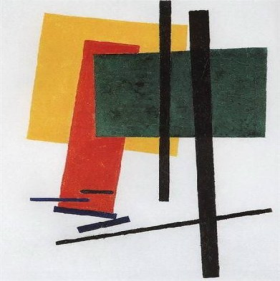
LISTENING
The Painter
On 25 October 1881 a little boy was born in Malaga, Spain. It was a difficult birth and to help him breathe, cigar smoke was blown into his nose! But despite being the youngest ever smoker, this baby grew up to be one of the 20th century's greatest painters - Pablo Picasso.
Picasso showed his truly exceptional talent from a very young age. His first word was lapiz (Spanish for pencil) and he learned to draw before he could talk. He was the only son in the family and very good-looking, so he was thoroughly spoilt. He hated school and often refused to go unless his doting parents allowed him to take one of his father's pet pigeons with him!
Apart from pigeons, his great love was art, and when in 1891 his father, who was an amateur artist, got a job as a drawing teacher at a college, Pablo went with him to the college. He often watched his father paint and sometimes was allowed to help. One evening his father was painting a picture of their pigeons when he had to leave the room. He returned to find that Pablo had completed the picture, and it was so amazingly beautiful and lifelike that he gave his son his own palette and brushes and never painted again. Pablo was just 13.
From then onwards there was no stopping him. Many people realized that he was a genius but he disappointed those who wanted him to become a traditional painter. He was always breaking the rules of artistic tradition and shocked the public with his strange and powerful pictures. He is probably best known for his "Cubist" pictures, which used only simple geometric shapes.
Picasso created over 6000 paintings, drawings and sculptures. Today a "Picasso" costs several million pounds. Once, when the French Minister of Culture was visiting Picasso, the artist accidentally spilt some paint on the Minister's trousers. Picasso apologized and wanted to pay for them to be cleaned but the Minister said, "No! Please, Monsieur Picasso, just sign my trousers!" Picasso died of heart failure during an attack of influenza in 1973.
Task 1
Mark + if the statement is true, - if it is false.
- A little boy was born on 25 October 1884.
- It was not a difficult birth.
- Pablo learned to draw before he could talk.
- He liked school.
- His great love was art and pigeons.
- His father got a job as a drawing teacher in 1891.
- Pablo wasn't allowed to help his father to paint the pictures.
- The picture which Pablo completed instead of his father was not so beautiful and lifelike
as his father's.
9. Picasso is best known for his "Cubist" pictures.
10. Picasso died of pneumonia in 1973.
Task 2
Circle the correct letter A, B, or C.
11. Where was Pablo Picasso born?
A. In Spain.
B. In Italy.
C. In France.
12. Why was it a difficult birth?
A. There were no doctors beside.
B. The mother died.
C. The baby couldn't breathe.
13. Why was the boy spoilt in his childhood?
A. Because he was very nervous.
B. Because he was the only son in the family.
C. Because the child had a week health.
14. Which people played a part in his career?
A. His father.
B. His mother.
C. His friends.
15. Which of the following numbers or dates relate to this person?
A. 1882
B. 79
C. 13
16. What did Picasso always shock the public with?
A. He was not breaking the rules of artistic tradition.
B. He was painting strange and powerful pictures.
C. He was only painting people.
17. What characterizes most of his pictures?
A. Realism.
B. Simple geometric shapes.
C. Soft colours.
18. What happened when the French Minister of Culture was visiting Picasso?
A. The artist split some paint on the Minister’s trousers.
B. The Minister paid one million pounds for his picture.
C. The artist presented a picture to him.
19. What did the Minister ask?
A. To sign the trousers.
B. To sell the picture.
C. To clean the trousers.
20. What does the number 6.000 refer to?
A. To the price of one of Picasso’s pictures.
B. To the total number of his paintings, drawings and sculptures.
C. To the number of sculptures Picasso created.
READING
FAMOUS ARTISTS
- What world famous painters do you know?
- Read the text below and decide if the statements given after it are true or false.
|
THE ARTISTS |
ABOUT THE ARTISTS |
FAMOUS WORKS |
|
Marc Chagall
|
Marc Chagall was born on July 7, 1887 in Vitebsk, Russia. In 1932 he moved to France. He lived in the United States from 1941 to 1948, and then returned to France. He died in France on March 28. 1985. His painting styles are Expressionism and Cubism . In his paintings, he often painted violinists because he played the violin and also in memory of his uncle, who also played. He was also famous for his paintings of Russian-Jewish villages. |
Angel over Vitebsk The Violinist I and the Village
|
|
Salvador Dali
|
Salvador Dali was born in Spain in 1904. When he was a child, he showed strange behavior and often interrupted his class in school. As he got older, he started to paint pictures that came from his dreams. His dreams and his paintings were scary and unreal. Dali went to art school in Madrid, Spain. He got kicked out, and never finished. He even spent time in jail. However, he continued to paint, and his art style became known as Surrealism . Salvador Dali drew everyday items, but changed them in odd ways. For example, one of his paintings is of melting clocks. Before he died at the age of 85 in 1989, Dali had created works in film, ballet, opera, fashion, jewelry, and advertising illustrations. |
The Persistence of Memory Crucifixion The Sacrament of the Last Supper
|
|
Leonardo Da Vinci
|
In 1452, Leonardo Da Vinci was born in an Italian town called Vinci. He lived in a time period called the Renaissance, when everyone was interested in art. Even though Da Vinci was a great artist, he became famous because of all the other things he could do. He was a sculptor, a scientist, an inventor, an architect, a musician, and a mathematician. When he was twenty, he helped his teacher finish a painting called The Baptism of Christ. When he was thirty, he moved to Milan. That is where he painted most of his pictures. Da Vinci's paintings were done in the Realist style. |
The Mona Lisa The Last Supper Madonna and Child The Virgin of the Rocks
|
|
Paul Klee
|
Paul Klee was born in Switzerland on December 18, 1887. He loved cats. He painted the a lot. He had at least 8,926 works of art. In these works of art, he used simple lines and strong colours. He also used simple shapes to make important parts of the painting. Klee painted in many styles, but a lot of them were in the Primitive and Surrealist styles. |
Fish Magic Around the Fish Landscape with Yellow Birds
|
|
Claude Monet
|
Claude Monet was born in 1840 on November 14 in Paris. Even when he was young he was a very good artist. His pictures were so good that an art supply store let him hang his pictures in their window. Monet's parents did not want him to become an artist because they thought he would not make a good living. That did not stop him though. When he was 20, he studied art at an inexpensive art school in Paris. Monet often went on trips around France to paint. . This is where he painted his Impressionist cathedral paintings that became very famous. His house also had a wonderful garden with a lily pond that had a Japanese bridge across it. These were his favourite things to paint. Monet died in 1926. Unlike many artists, he was famous even before he died. Now his house in Giverny is a museum that is visited by many people. |
Morning Haze Marine Near Etretat Lily Pond
|
|
Pablo Picasso
|
Pablo Picasso was born in Malaga, Spain on October 5, 1881. His father, Jose Ruiz, was also an artist. Picasso painted in many styles, including Cubism and Expressionism. He also sculpted. In cubism, he tried to show the dimensions of the objects in his paintings. When he painted in the classical style, his shapes were round and soft. In cubism, his shapes were square and hard. When Picasso painted, he had a blue period and a rose period. For about three years in his early twenties, he used mostly light blue colours in his paintings. The rose period came after the blue period. It began after he moved from Spain to France. Because he could work in multiple styles, Picasso became very famous. He used great lines and colour in his paintings. |
Guernica Three Musicians The Three Dancers Self Portrait: Yo Picasso
|
|
Vincent Van Gogh
|
Van Gogh was born in Holland in 1853. He worked at many jobs, such as at an art gallery, a bookstore, as a preacher, and at last, he became an artist. He didn't have a very happy life. He painted sad paintings with poor people in them. His paintings were always very dark until he saw some colorful Japanese paintings. Then Van Gogh started painting happier paintings. Most of his work was in the Postimpressionist style. One day, he moved to live with his brother because he was unhappy where he lived, and he wanted to find someone to paint with. When he finally found someone, he wished he hadn't. Van Gogh and the other artist did not get along. After this, Van Gogh became so sad that he cut part of his ear off! After these things happened, he painted one more gloomy painting. It was called Wheatfield with Crows. After he finished it, he shot himself. |
The Starry Night Wheatfield with Crows Sunflowers |
|
Andy Warhol
|
Andy Warhol was born in Pittsburgh, Pennsylvania in 1928. Andy was born with a natural talent for art. His mother encouraged him with his drawings. His teachers thought he had such a good talent for art that he should go to weekend art class. When his family saved enough money to send Andy to art college, he went to Carnagie Institute of Technology, where he studied design and illustration. That's where he developed his unusual art style. When he graduated from school he went to New York City for a job. He got jobs doing magazine illustrations, decorating department store windows, greeting cards, record albums, book covers, and suns, clouds, and raindrops for television weather reports. He still was not satisfied because he was not famous. His friend suggested him to draw everyday items. This was called Popular, or Pop Art. People liked his pictures because they were bright, attractive, and familiar. Warhol liked getting people’s ideas for new drawings. He also tried making films. Warhol died in 1987. By that time, he was a famous artist. His works made people think of the important, everyday things in their lives. |
Campbell's Soup Can 100 Soup Cans
|
Statements
1. In his paintings, Marc Chagall often used geometric shapes.
2. Salvador Dali painted everyday items in strange and mysterious ways.
3. Leonardo Da Vinci painted in Abstract style.
4. Paul Klee had a few works of art.
5. Claude Monet’s favourite thing to paint was a lily pond with a Japanese bridge across it.
6. Picasso became very famous because he could work in many styles.
7. Van Gogh’s paintings were always bright and colourful.
8. The works of Andy Warhol were attractive and bright.
Vocabulary
ART
- something that an artist has produced
art [n U] a way of representing things or expressing ideas, using pictures, sculpture, and other objects that people can look at: a book about German art in the 19th century. Is a pile of bricks in a gallery really art? What kind of art do you like?
work of art [n C] something produced by an artist, especially something that most people agree is of very high quality: Several priceless works of art were badly damaged when the palace was bombed.
Plural: works of art
work [n C] a picture, statue, sculpture etc - use this especially when you are also saying who the artist was: David Hockney's latest work has just gone on display. Her later works reflected her growing depression.
masterpiece [n C] a picture, statue etc that is of extremely high quality, especially one that is believed to be the best work of a particular artist: one of the great Italian masterpieces. Many people regard this painting as Raphael's masterpiece.
|
/!\ You can use work of art, work, and masterpiece about any kind of art. |
2. types of picture
painting [n C] a picture made using paint: a 17th century Dutch painting + of a painting of a woman lying on a bed + by a painting by Turner oil painting (=done using a special type of paint made with oil)
drawing [n C] a picture drawn with pencils or pens
+ of a 16th century drawing of the canals in Venice
photograph [n C] a picture made using a camera
mosaic [n C] a picture made using very small pieces of glass or stone
collage [n C] a picture made by sticking paper, cloth, or other pictures onto a surface
watercolour (British) watercolor (American) [n C] a picture painted using a special type of paint that is mixed with water, so the colours are pale
|
|
Portrait [n C] a picture of a person |
|
|
Still life [n C] a picture of an object or several objects, especially fruit or flowers |
|
|
Landscape [n C] a picture of the countryside |
|
|
Seascape [n C] a picture of the sea |
3. other types of art
sculpture [n C/U] a work of art made of materials such as stone, metal, or wood
|
|
Statue [n C] an image of a person or animal made from a hard material such as stone or metal |
ceramics [n plural] pots, bowls etc made of clay
|
/!\ Ceramics is always used in the plural: an exhibition of Japanese ceramics. Don't use ceramics when you are talking about one bowl. Say 'a bowl', 'a plate' etc. |
4. the subject of a picture, painting etc
of [preposition] use this to show what the subject of a picture, painting etc is: a portrait of King Charles I, a statue of a horse
depict [v T] formal if a painting or other piece of art depicts something, that is what it shows or represents: Her drawings depict life in an African village.
5. someone who draws, paints etc
artist [n C] someone who produces paintings, sculptures, or any kind of art: an exhibition of work by young artists
painter [n C] someone who produces paintings: Pissarro was a famous French painter.
sculptor [n C] someone who produces sculptures
photographer [n C] someone who takes photographs
6. to make drawings, pictures etc
paint [v I/T] to make a picture using paint: Botticelli painted 'The Birth of Venus'.
draw [u I/T] to make a picture using a pencil or pen: The students were drawing a Chinese vase that stood on the table. I Where did you learn to draw like that?
photograph [v I/T] to take a photograph of someone or something: Eve Arnold photographed Marilyn Monroe many times.
|
/!\ Don't say 'I photographed my friends on the beach'. Say I took a photo of my friends or I took a picture of my friends. Only use the verb photograph about artists or professional photographers. |
7. a place where art is shown
gallery also art gallery [n C] a building or room where you can go to look at paintings, sculptures etc: the National Gallery. There's a small art gallery in the centre of the town.
|
/!\ In American English gallery is only used about a room or a small building |
museum [n C] American a large building where you can go to look at paintings, sculptures etc: The Museum of Modern Art. The museum has a few of Van Gogh's early works.
exhibition [n C] a collection of paintings, sculptures etc, often the work of one particular artist, which you can go to see - use this especially when they aft only being shown for a limited peril id "I time: Have you been to the Picasso exhibition yet?
+ of an exhibition of black and white photograph
8. styles of art
|
|
Classical – (adj.) the main style of art in 18th century Europe, based on the styles of ancient Greece and Rome, often showing scenes and characters from the Christian religion |
|
|
Romantic – (adj.) a style of art popular in 19th century Europe, often showing the sea or the countryside, and Usually expressing strong emotions |
|
|
Impressionist – (adj.) a style of art that was developed in France in the late 19th century, which uses colours to show the effects of light on people, objects, and places, and does not show small details |
|
|
Modern – (adj.) the style of art in the 20th century that is deliberately different from art of the 18th and 19th centuries, and does not show people, objects, or places as they appear in real life |
|
|
Abstract – (adj.) a type of modern art that uses shapes, colours, and patterns to express ideas and feelings, rather than pictures that look like people, objects, or places |
- Read and match the words with their definitions.
|
a) a picture made using very small pieces of glass or stone |
|
|
2. Drawing |
b) a picture made using paint |
|
3. Photograph |
c) pots, bowls etc made of clay |
|
4. Mosaic |
d) a work of art made of materials such as stone, metal, or wood |
|
5. Collage |
e) a picture drawn with pencils or pens |
|
6. Sculpture |
f) a picture made by sticking paper, cloth, or other pictures onto a surface |
|
7. Ceramics |
g) a picture made using a camera |
2. Match the words with similar meanings
|
1. 2. 3. 4. 5. 6. 7. 8. |
Work of art Painting Artist Depict Art gallery Paint Type Prominent |
a) b) c) d) e) f) g) h) |
draw show museum outstanding masterpiece painter picture style |
3. Find eight words connected with art in the wordsearch box and use some of them in plural to complete the sentences below.
|
g |
n |
i |
t |
n |
i |
a |
p |
t |
n |
|
b |
o |
a |
m |
o |
n |
p |
l |
j |
o |
|
r |
f |
s |
s |
i |
l |
o |
y |
g |
i |
|
z |
p |
i |
c |
t |
u |
r |
e |
n |
t |
|
q |
k |
t |
u |
c |
m |
t |
v |
i |
i |
|
o |
v |
t |
l |
e |
g |
r |
d |
w |
b |
|
s |
h |
n |
p |
l |
n |
a |
d |
a |
i |
|
r |
b |
i |
t |
l |
r |
i |
a |
r |
h |
|
q |
t |
a |
o |
o |
p |
t |
h |
d |
x |
|
p |
j |
p |
r |
c |
b |
x |
c |
e |
e |
|
painting portrait exhibition collection paint picture drawing sculptor |
- He did all his ……… with a charcoal.
- He has painted the ……… of a lot of famous people.
- Van Gogh’s “Sunflowers” is one of the most famous ……… in the world.
- The museum has one of the world’s finest ……… of impressionist paintings.
- Her first works were the ……… made with water-colour.
READING
1. Answer the questions.
1) Have you ever heard of the Mona Lisa?
2) Do you know anything about this painting?
The Da Vinci Code
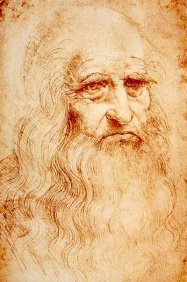
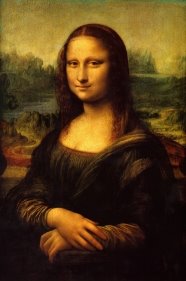
Despite her monumental reputation, the Mona Lisa was a mere thirty-one inches by twenty-one inches—smaller even than the posters of her sold in the Louvre gift shop. Painted on a poplar wood panel, her ethereal, mist-filled atmosphere was attributed to Da Vinci's mastery of the sfumato style, in which forms appear to evaporate into one another.
Since taking up residence in the Louvre, the Mona Lisa or La Joconde had been stolen twice, most recently in 1911. Parisians wept in the streets and wrote newspaper articles begging the thieves for the painting's return. Two years later, the Mona Lisa was discovered hidden in the false bottom of a trunk in a Florence hotel room.
The Mona Lisa's status as the most famous piece of art in the world, Langdon knew, had nothing to do with her enigmatic smile. Nor was it due to the mysterious interpretations attributed her by many art historians. Quite simply, the Mona Lisa was famous because Leonardo da Vinci claimed she was his finest accomplishment. He carried the painting with him whenever he travelled and, if asked why, would reply that he found it hard to part with his most sublime expression of female beauty.
Even so, many art historians suspected Da Vinci's reverence for the Mona Lisa had nothing to do with its artistic mastery. In actuality, the painting was a surprisingly ordinary sfumato portrait. Da Vinci's veneration for this work, many claimed, stemmed from something far deeper: a hidden message in the layers of paint. The Mona Lisa was, in fact, one of the world’s most documented inside jokes. The painting's playful allusions had been revealed in most art history tomes, and yet, incredibly, the public at large still considered her smile a great mystery. No mystery at all, Langdon thought, moving forward and watching as the faint outline of the painting began to take shape. No mystery at all.
Most recently Langdon had shared the Mona Lisa's secret with a rather unlikely group—a dozen inmates at the Essex County Penitentiary. Langdon's jail seminar was part of a Harvard program attempting to bring education into the prison system—Culture for Convicts, as Langdon's colleagues liked to call it.
Standing at an overhead projector in a darkened penitentiary library, Langdon had shared the Mona Lisa's secret with the prisoners attending class, men whom he found surprisingly engaged—rough, but sharp. "You may notice," Langdon told them, walking up to the projected image of the Mona Lisa on the library wall, "that the background behind her face is uneven." Langdon motioned to the glaring discrepancy. "Da Vinci painted the horizon line on the left significantly lower than the right. This is a little trick Da Vinci played. By lowering the countryside on the left, Da Vinci made Mona Lisa look much larger from the left side than from the right side. A little Da Vinci inside joke. Historically, the concepts of male and female have assigned sides—left is female, and right is male. Because Da Vinci was a big fan of feminine principles, he made Mona Lisa look more majestic from the left than the right."
"I heard he was a fag," said a small man with a goatee.
Langdon winced. "Historians don't generally put it quite that way, but yes, Da Vinci was a homosexual."
“Is that why he was into that whole feminine thing?"
“Actually, Da Vinci was in tune with the balance between male and female. He believed that a human soul could not be enlightened unless it had both male and female elements."
"Hey, Mr. Langford," a muscle-bound man said. "Is it true that the Mona Lisa is a picture of Da Vinci in drag? I heard that was true."
"It's quite possible," Langdon said. "Da Vinci was a prankster, and computerized analysis of the Mona Lisa and Da Vinci's self-portraits confirm some startling points of congruency in their faces. Whatever Da Vinci was up to," Langdon said, "his Mona Lisa is neither male nor female. It is a fusing of both. Da Vinci left a big clue that the painting was supposed to be androgynous. Has anyone here ever heard of an Egyptian god named Amon?"
"Hell yes!" the big guy said. "God of masculine fertility!"
"Well done. And do you know who Amon's counterpart was? The Egyptian goddess of fertility?"
The question met with several seconds of silence.
"It was Isis," Langdon told them, grabbing a grease pen. "So we have the male god, Amon." He wrote it down. "And the female goddess, Isis, whose ancient pictogram was once called L’ISA."
Langdon finished writing and stepped back from the projector.
“AMON L'ISA”
"Mona Lisa..." somebody gasped.
Langdon nodded. "Gentlemen, not only does the face of Mona Lisa look androgynous, but her name is an anagram of the divine union of male and female. And that, my friends, is Da Vinci's little secret, and the reason for Mona Lisa's knowing smile.”
After Dan Brown
2. Match the words with their definitions.
|
1. Androgynous |
a) a person or thing that has the same purpose or does the same job as another in a different system; |
|
|
2. Congruency |
b) a thing having the same size and shape as another; |
|
|
3. Counterpart |
c) a person who plays pranks; |
|
|
4. Drag |
d) having both male and female characteristics; |
|
|
5. Goatee |
e) a prison, especially in the US; |
|
|
6. Penitentiary |
f) the clothing of one sex worn by the other; |
|
|
7. Prankster |
g) a little pointed beard on the bottom of the chin, like the hair on a male goat’s chin. |
|
3. Find the sentences with similar meanings in the text. Put the sentences into the correct order according to the text.
1) Da Vinci said that the Mona Lisa was his best work.
2) Da Vinci tried to find the balance between male and female.
3) The Mona Lisa is a portrait of Da Vinci in a dress.
4) The Mona Lisa’s face is androgynous.
5) The painting has a mysterious smile.
6) Da Vinci said it was difficult for him to part with the Mona Lisa.
4. Read and say if the statements are true or false.
1) The Mona Lisa is not very large in size.
2) It is painted on a canvas.
3) Da Vinci’s reverence for the Mona Lisa is connected with the artist’s mastery.
4) Langdon gave the prisoners a lecture on the Mona Lisa’s secret.
5) Da Vinci thought that a human soul could not be enlightened unless it had both male and female characteristics.
6) The Mona Lisa and Da Vinci’s self-portraits don’t show the congruency in their faces.
5. Work in pairs. Discuss the questions.
1) Why did Da Vinci carry the painting with him whenever he travelled?
2) Why did Da Vinci paint the horizon line on the left significantly lower than the right?
3) What is the main idea of Da Vinci’s principles?
4) What new information did you get from the text?
PRESENTATION “Genres of art”
1
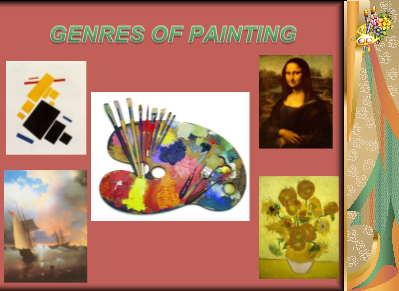
2
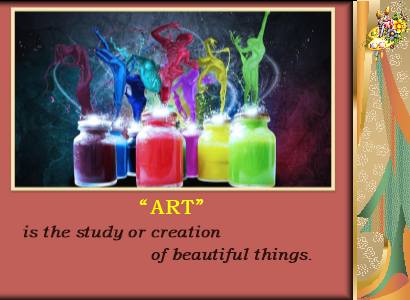
3 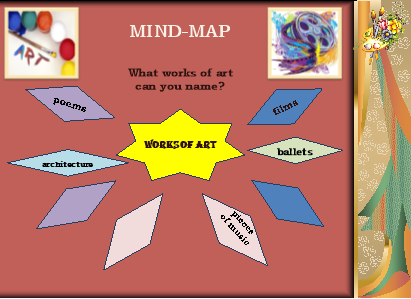
4
5
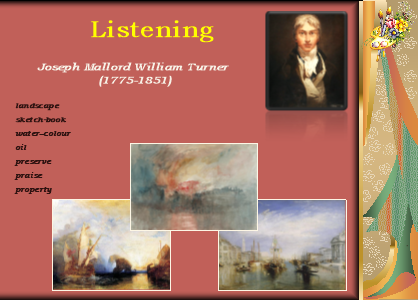
6
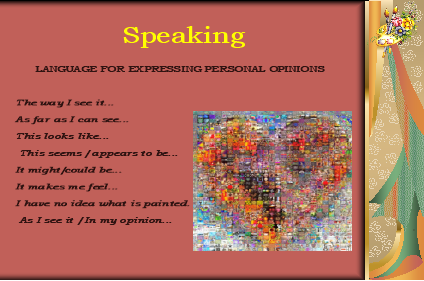
7
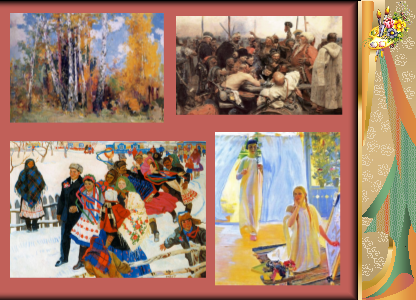
8
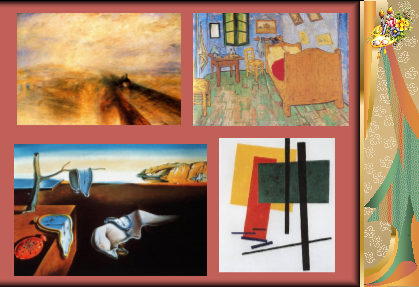
9
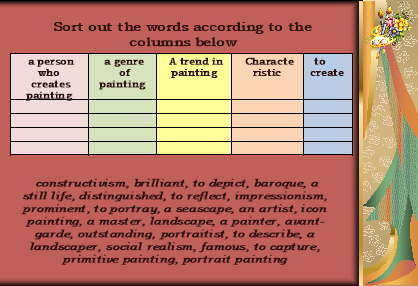
10
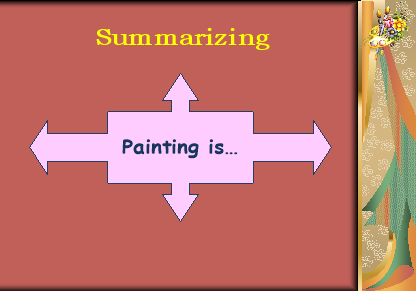
11
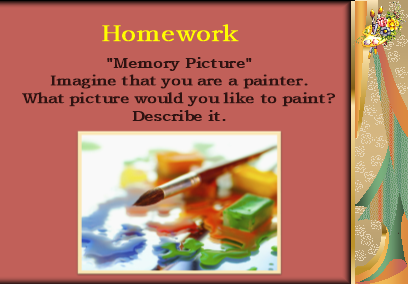
GRAMMAR
- Change the sentences using passive structures.
- This museum changes its exhibitions regularly.
- At the moment the museum is showing paintings by artists who all live in the area.
- Da Vinci painted the Mona Lisa in the sfumato style.
- Somebody has stolen this picture twice since 1901.
- They will deliver the painting tomorrow.
- He painted people in a gentle, thoughtful style.
- Put the wh-questions to the following sentences.
- All the exhibits in this attractive little museum were produced in the region over the last 100 years.
- His work was influenced by art from Africa which he saw in museums.
- Several priceless works of art were badly damaged when the place was bombed.
- David Hockney’s latest work has just gone on display.
- A Chinese vase was drawn by his student.
- Although Van Gogh was poor during his life, his paintings are now sold for very high prices.
- Read the text about art galleries and put the words in brackets into Present or Past Simple Passive.
Art Galleries
If you stand in Trafalgar Square with your back to Nelson’s Column, you will see a wide horizontal front in a classical style. It is the National Gallery. It has been in this building since 1838 which (1)….(to build) as the National Gallery to house the collection of Old Masters Paintings (38 paintings). It (2)….(to offer) to the nation by an English private collector, Sir George Beamount.
Today the picture galleries of the National Gallery of Art exhibit works of all the European schools of painting which existed between the 13th and 19th centuries.
With over 2000 paintings, it is one of the leading museums in the world. Among the old masters exhibited there are Titian, Botticelli and Da Vinci. The works of the Flemish and Dutch schools are no less significant. Take for example, Jan van Eyck, Vermeer, Breughel and Rembrandt. The collection of French impressionists and post-impressionists like Van Gogh is extraordinary. The National Portrait Gallery is right around the corner. It is the biggest portrait collection in the world and a mirror of English history. Pictures of people who were in the public eye in Britain (3)….(to exhibit) there. Amongst others are Henry VIII, his daughter from his 2nd marriage, Queen Elizabeth I, and the humanist Thomas Morus, the actor and dramatist Shakespeare and Charles Dickens, author of Oliver Twist.
The idea of opening the Tate Gallery took shape in 1890. That year Henry Tate’s gift of sixty-five paintings and two sculptures, almost all of them the work of Victorian contemporaries, (4)….(to offer) to the nation, but a gallery had still to be built to house them. When opened seven years later, the Tate Gallery consisted of eight rooms and (5)…. (to intend) as a collection of contemporary British painting only; it was, moreover, a mere annex to the National Gallery, Trafalgar Square.
Most of the National Gallery British paintings (6)….(to transfer) to the Tate, and only a small collection of a few masterpieces (7)….(to exhibit) at Trafalgar Square now. Thus, the Tate Gallery exhibits a number of interesting collections of British and foreign modern painting and also modern sculpture.
The modern collection includes the paintings of Henri Matisse and Pablo Picasso, Marc Chagall and Salvador Dali, Francis Bacon and Graham Sutherland, Peter Blare and Richard Hamilton, the chief pioneers of pop art in Great Britain. Henry Moore is a famous British sculptor whose works (8)….(to exhibit) at the Tate too.
1


про публікацію авторської розробки
Додати розробку


